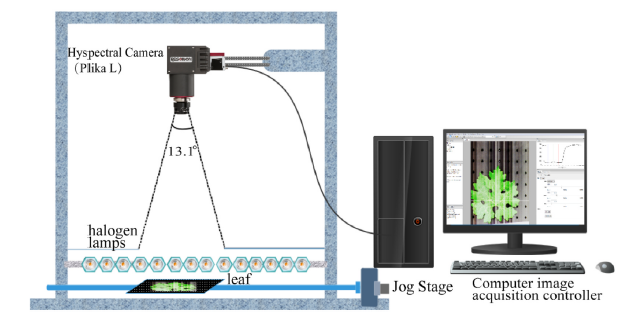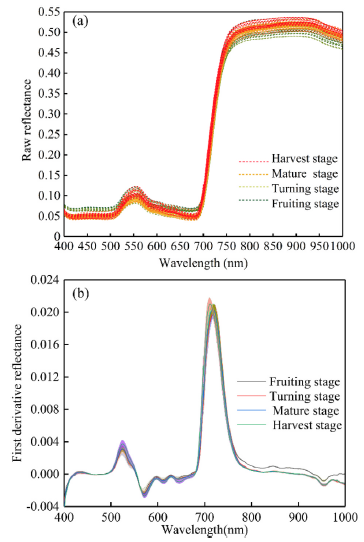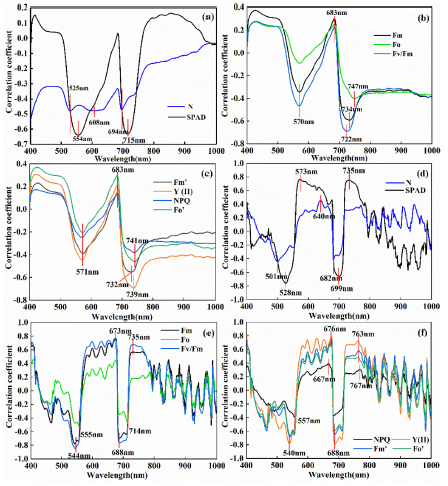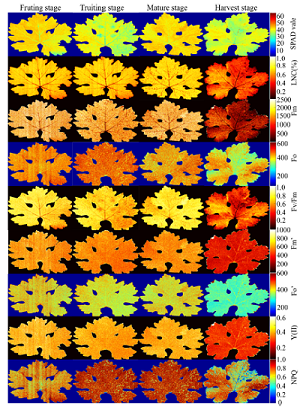Application of Resonon Pika L on quantifying leaf-scale chlorophyll, nitrogen and chlorophyll fluorescence parameters in grapevine
Rapidly and accurately monitoring the physiological and biochemical parameters of grape leaves is the key to controlling the quality of wine grapes. Traditional methods for determining the physiological and biochemical parameters of crops require the collection of a large number of samples, which is time-consuming, labour-intensive and costly. As it is non-destructive and highly efficient, remote sensing-based spectral detection can overcome the limitations of other methods used to determine crop physiological and biochemical parameters and meet the requirements for agricultural production with precision agriculture. In particular, hyperspectral imaging technology not only provides rich spectral information but also reflects crop growth conditions visually in a way that is easy to understand; therefore, it provides significant advantages over other methods of evaluating crop physiological and biochemical parameters.
Based on this, in the attached article “Application of a hyperspectral imaging system to quantify leaf-scale chlorophyll, nitrogen and chlorophyll fluorescence parameters in grapevine”, a group of scientists conducted related experiments, aiming to (1) explore the response patterns of the LNC and chlorophyll contents to ChlF parameters under dark-adapted and light-induced conditions during grape ripening; (2) find the wavebands and vegetation indices that are sensitive to nitrogen, chlorophyll and ChlF parameters by obtaining the hyperspectral reflectance of grape leaves; and (3) establish an optimal prediction model for nitrogen, chlorophyll and ChlF parameters by using sensitive bands and vegetation indices.
The authors took the samples from a commercial wine estate at the eastern base of Helan Mountain in Ningxia Province, China (38°42′N, 106°03′E), which is located on the plains in the Yellow River Basin. They measured the ChlF parameter, LNC and chlorophyll of the leaf. Then they acquired the hyperspectral images using an indoor hyperspectral imaging system (Resonon Pika L) with the computer control software SpectrononPro. Finally, they selected the sensitive bands and calculate the new vegetation indices.

Hyperspectral image acquisition system in laboratory.

(a) shows the raw reflectance characteristics of all samples at different growth stages. (b) shows the first derivative reflectance for all samples at different growth stages.

(a–c) are correlation coefficient curves of raw reflectance with SPAD, LNC, and ChlF parameters; (d–f) are correlation coefficient curves of first derivative reflectance with SPAD, LNC, and ChlF parameters. The peaks and valleys of the correlation curves marked in the graph are the selected characteristic spectral bands.

SPAD, LNC and ChlF parameters map at the leaf level estimated by the new vegetation indices in this study.
In total, the results showed that the dark-adapted ChlF parameters (Fo, Fm, FV/Fm) and light-adapted ChlF parameters (Fo’, Fm’ and Y(II)) showed a decreasing trend from the fruiting stage to the harvesting stage, while SPAD reached its maximum at the turning stage and then started to decrease. LNC reached its maximum at the mature stage and then started to decrease, while NPQ showed large, fluctuating changes. The new vegetation indices NDSVI, SDCSVI, and NDSFRVI were calculated by combining the wavebands of raw reflectance and first-derivative reflectance that were sensitive to and obtained a linear fit with these parameters. The results showed that (D735-D573) / (D735+D573) showed good predictive ability for SPAD; (D735-D544) / (D735+D544) showed good predictive ability for FV/Fm; showed good predictive ability for Fm, and D676/R571 showed good predictive ability for Y(II) and Fm’. The sensitive wavebands screened by correlation analysis provide a basis for hyperspectral imaging techniques to predict the parameters investigated in this study. In addition, this study collected spectral information from detached leaves, however, under natural conditions, somethings (xanthophyll conversion, chloroplast movement, etc.) cause photosynthetic changes, and these changes also have an impact on predicting ChlF parameters. However, the results in this paper show that even for detached leaves, SPAD, LNC and ChlF parameters still have excellent spectral response relationships, which provide a reference for accurate vineyard management.
 6376352097812215636811383.pdf
6376352097812215636811383.pdf